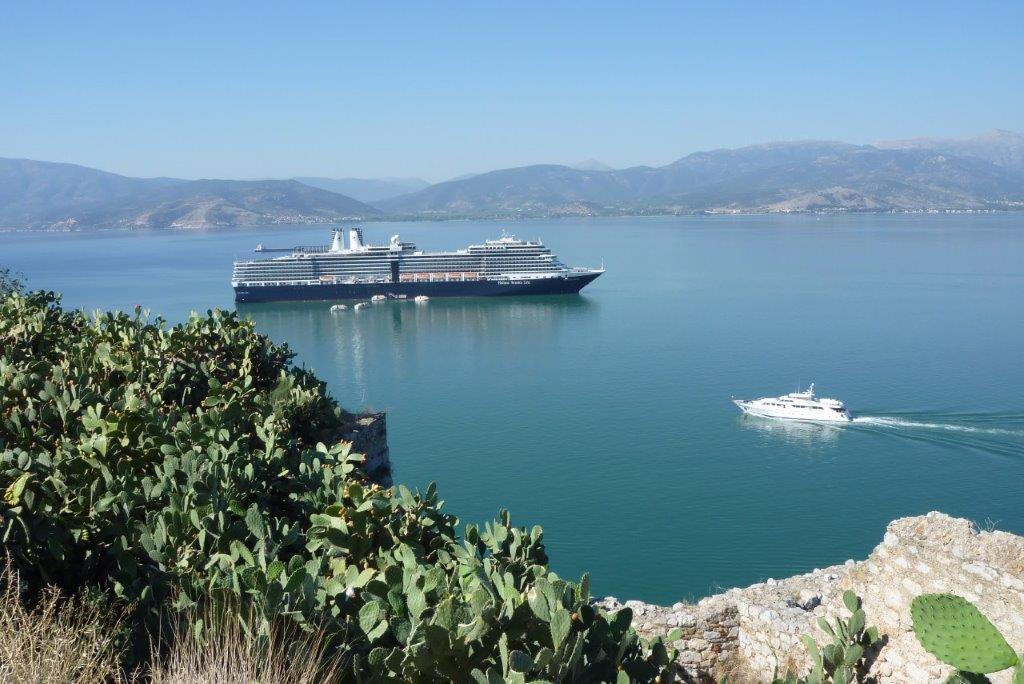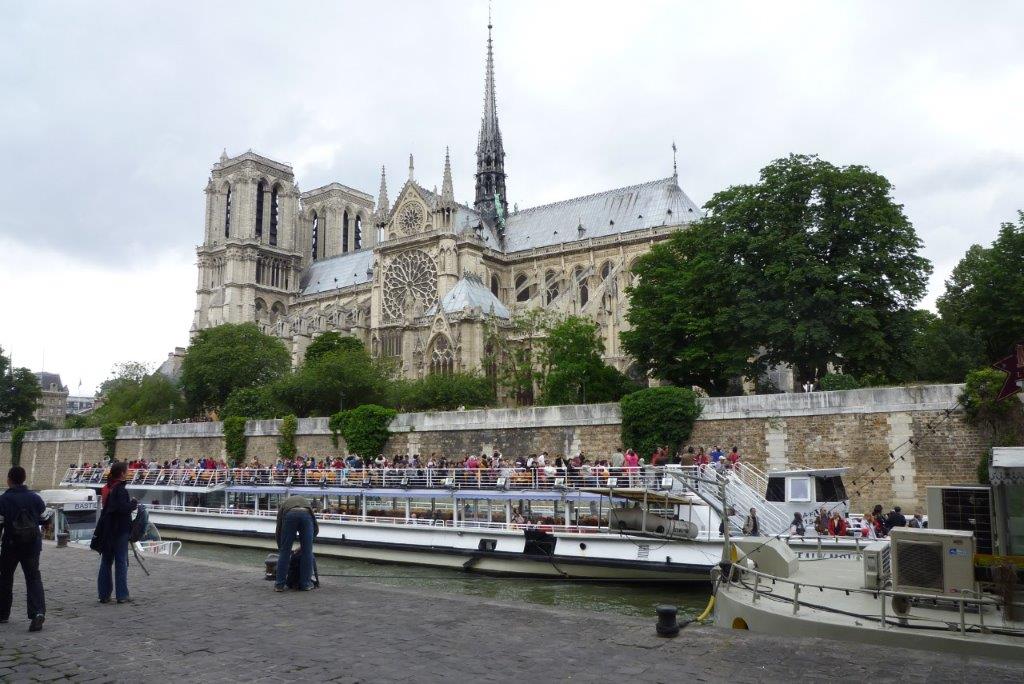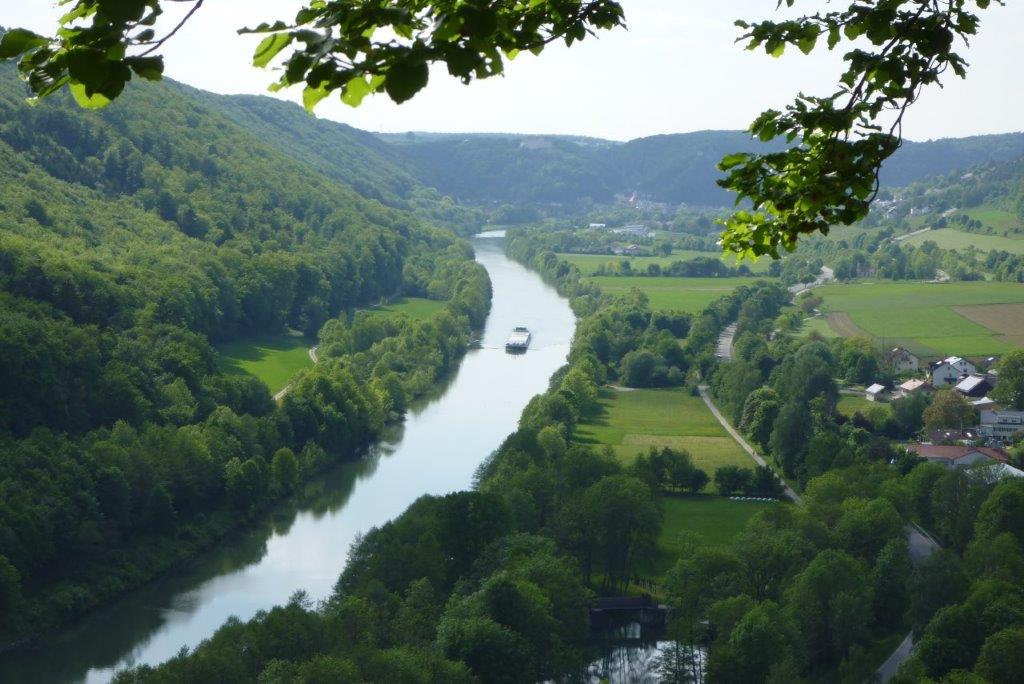Seeing Europe by boat

Photo by Jerry Cvach
Cruise ship anchored in Greece.
Seeing the European continent from a cruise ship is a very different experience. We booked our first cruise in 1988, and how the times have changed since then.
When we were packing back then, we needed an extra suitcase just for evening clothes. We were getting ready for fancy dining, night performances, dancing and such. We weren’t on an expensive cruise line either, just on a modest Epirotiki ship named Pegasus, touring around the Greek islands.
Pegasus eventually caught fire and sank in Venice in 1991 and the wearing of evening clothes and posh dining on common cruises seems to have also sunk somewhat since then.
On our next cruise we went from Barcelona in Spain to Venice in Italy, via France, Greece and Croatia. Most participants transferred directly from the airport to the port. The cruise sailed in the evening and the itinerary didn’t even include visiting the city, though, in fact Barcelona is one of the “must see” cities in the world.
At least two days are needed to explore Barcelona reasonably well, and that doesn’t even include a chance to visit the nearby attractions like Monserrat, Cadaques and Besalu. It was better at the other end of the trip as we had an extra day to see Venice, but it was still not enough time.
So we brought in our first rule of booking a cruise. We book extensions to our trip in order to explore the cities of origin and/or the end of the cruises. This applies, if the tours originate or end in these cities so that we can experience their attractions: Amsterdam, Budapest (Szentendre), Bucharest (add Transylvania), St. Petersburg (the Czar’s residences in the country) and Moscow (ballet), or any other cruises for that matter.
Tours often include visits to signature cultural events in selected cities, but because of the sheer volume of travellers, the trips to the famous venues often don’t have the required capacity. We visit the tourist performances included in the cruise itinerary even though they are “minor leagues” of the real things. We go to see the commercial Russian ballet companies, concerts in the Musikverein in Vienna, classical concerts in Prague, churches, and the like.
So our next rule is that if you want to see the real thing, book in advance on the Internet. Even though the tourist shows are still good in St. Petersburg or Moscow, the unadulterated ballets in the famed Mariinsky or Bolshoi theaters respectively are truly exquisite!
On our second cruise, we soon found out that they still serve dinners on ships, albeit not formal, of course. On sea cruises the seating is fixed so one dines with the same people every day. The dinner topics are mostly centered on what was seen that day and what attractions to select for tomorrow.
Cruise companies provide booklets with the options and there are usually information sessions in the evening before the next stop. The trouble is that all the options look enticing, some indeed are, but some are overrated. It helps to have some prior knowledge to make educated decisions.
Probably the best example of this was before we arrived in Livorno, in Italy. From the tourist point of view it is a hellhole commercial port and the city is bland, with nothing to see other than the crumbling fort in the old port. The difficult choice we were given was between going to Florence, or to Pisa combined with Lucca, maybe Cinque Terre, or possibly to San Gimignano.
For the first-time traveller Florence is probably a must, but one day can’t do it justice. It may be better to save it for a land trip and schedule at least two full days. Pisa has a leaning tower and a dome as everyone knows, surrounded by souvenir stands, but frankly there is not much more there, so the tours often include the town of Lucca 22 kilometers away that is more interesting on the whole, even though the church tower is straight.
Cinque Terre is an absolutely fascinating stretch of dramatic coast with five picturesque towns in a row tucked into tiny triangles of flat land inaccessible by passenger cars. Tour buses drop you off above the first town, Riomaggiore, and you can walk to at least the next town, Manarola. It is a wonderful introductory visit.
San Gimignano is the one and only town in the world where patrician houses were built as fortresses complete with towers so that from a distance the city looks like a stone porcupine – not much brotherly love among the mediaeval citizenry obviously. Sadly, with all of these other glamorous options available, the shuttle bus to Livorno was still busy all day.
Arriving in Naples, it is a bit easier to decide. You choose between the city itself and the ruins of Pompeii. If it’s your first trip, Pompeii will look better on your resume. It is fascinating for sure. If you have already visited Pompeii, other good day trips are the Amalfi loop or a boat trip to Capri. Be warned though that both excursions are very busy in the main season.
Our third rule was making sure to consider what kind of experience we wanted: whether we wanted to cruise by sea or river, or to drive to our destinations. However, a vacation by a sea- or river-cruise is much more about the land visits than the sailing. Cruising is limited in scope, though it still covers a disproportionately large part of European history and culture. Many of the oldest and most famous cities are located by the sea or within driving distance from it or on navigable rivers.
These cities were founded and rose to prominence way back before cars and airplanes were invented. The rivers and the sea along the shores were the infrastructure of our forefathers, just as the rivers were later to voyageurs in Canada. The difficulties of overland travel prevented other settlements from being built. Today, it is hard to imagine that the ancient Greeks or medieval Spaniards found the rugged land between their major population centres so hard to cross that they would rather sail around. But then the mountain ranges were impenetrable, full of obstacles, robbers and fairy-tale monsters. When I was young I didn’t understand that the Roman Empire was successful not only because of its military prowess and seafaring, but also because of its excellent road-building abilities.
There are some fundamental differences between sea and ocean cruises. If luxury sea voyages right out of Victorian times complete with social and entertainment events are your thing, it’s better to take an ocean cruise.
The more popular sea cruises operating on the small Baltic and Mediterranean seas hug the shore as the little Greek and Roman boats did in pre-Christian times. The luxury floating hotel that you are on, takes you to the next destination while you sleep and because there is not that much to see from the ship when at sea, it is a very efficient way to vacation, as you don’t miss much.
These cruises stop in exotic locales like Monte Carlo, Kerkira, Dubrovnik and Venice. Most of the Baltic port cities are tourist attractions meriting a long visit, although even these cruises offer short half-day excursions if you want to split your day.

Places not to miss would include the Hanging Villages (Villages Perchés) like Vance and Gourdon in the mountains behind Monte Carlo, a tour of Corfu from Kerkira, Cavtat from Dubrovnik or Burano from Venice. It is not just Livorno, but also Civitavecchia and Katakolon that have no appeal whatsoever for visitors and are just jump-off points to see Rome and ancient Olympia respectively, so there are no tough decisions to make there.
If you are thinking of heading north, the Scandinavian countries are much more about untouched nature, very enticing for Europeans, perhaps not so much for Canadians, as we are blessed with so much of our own untouched nature. It’s also not easy to savour nature when on a cruise ship. The cities Oslo and Bergen in Norway and St. Petersburg in Russia were the best. It is also probably more interesting, and faster, to sail rather than to drive to the arctic along the Norwegian coast, as we have done.
Our last rule is to consider taking a river cruise, if one is available. The coast-hugging sea cruises are good and it is hard to improve on the comfort they provide, but river cruises allow for seeing not just the highlights, but also the countryside.
The smaller river cruise ships discharge fewer tourists. It is unimaginable what would happen to the many lovely towns like Rudesheim or even Bamberg in Germany, not to speak about tiny Durnstein in Austria if one of those sea-faring behemoths would let out some 3000-plus camera-toting tourists at one time in these small locals.
An added benefit of a river cruise is being able to watch the countryside unfold in front of your eyes from your cabin’s balcony, with a glass of wine in your hand, as the advertisements are quick to point out. The busiest river cruise routes are the Danube and Rhine rivers. Connected through the river Main and the Europa Kanal between Bamberg and Kelheim, they form an east west corridor that makes sailing from the English Channel to the Black Sea possible.
It is a tourist route made in heaven. It would take three to four weeks to go from Amsterdam to Bucharest in Romania. Typically it is broken down to two separate trips. Amsterdam to Budapest in Hungary is the western leg, and then further to Bucharest is the eastern leg. The highlights of the eastern leg are Bucharest from where it is recommended to add on an excursion to be able to visit Transylvania (Dracula country), the Iron Gates, that is a Danube gorge, Beograd, and Budapest. When starting in Budapest and going west the second stop already is the spectacular Vienna, followed by Wachau Valley, Passau and Regensburg.

Further down the Main River there is Wurzburg, at one time the Rhine confluence with Main, it enters a gorge with a multitude of castles on each side of the river, and even one built in the center of the river, the Pfalzgrafenstein. The Rhine was a major trade route in the Middle Ages so that everyone who had any influence and money wanted to build a castle on the shore, so that they could throw a chain across the river and collect tolls, Roman Catholic bishops included. Some of the castles are ridiculously close to each other, in one case there are two which had been owned by feuding brothers. Between Coblenz and Amsterdam there are the mildly interesting cities of Cologne and Bonn, but Amsterdam is one of Europe’s best destinations.
The only difficult stop for choosing the right day trip away from the river is Regensburg. All the choices are good. You can go either to Salzburg in Austria, Prague in Czech Republic or stay in the city. To help you choose, consider that Salzburg can be viewed in one day, while Prague requires at least two days, plus another day because from there one ought also to visit the nearby Cesky Krumlov, a jewel among central European towns.
For visiting the Czech Republic properly from a cruise ship there is just not enough time. It might be best to throw caution to the wind and settle for having a beer on the patio in the Regensburg cathedral square instead.
There are many shorter Danube River cruises that include a visit to Prague at the beginning or the end, but that would be another vacation. If you have to decide between excursions to Basel up the Rhine River or to Trier on Mosel River, I would choose the latter.
Other cruises operating on navigable rivers and adjacent canals are Douro in Portugal, Rhone and Seine in France that are short, under a week long and usually end either in Paris, or Lisbon to make them more attractive. There is also a cruise on the Elbe River that includes Berlin and Prague. Only part of this trip is actually sailing. The cities at each end are fascinating.
Last but not least there is the St. Petersburg to Moscow cruise in Russia. It is different from all other European cruises as one visits two world-class metropolises, and then sails between them through the vast Russian bucolic beech forests on rivers, canals and lakes, an experience straight out of the 19th Century. It is like everything Russian, big, slow and melancholy. The absolute highlight is St. Petersburg, its history, palaces and white nights in summer.
Beware that cruising has a catch. You see a good sample of the best of Europe and it leaves you wanting more cruises or more overland trips as there is so much outside of the narrow strip of the continent that you saw. You are now hooked.
